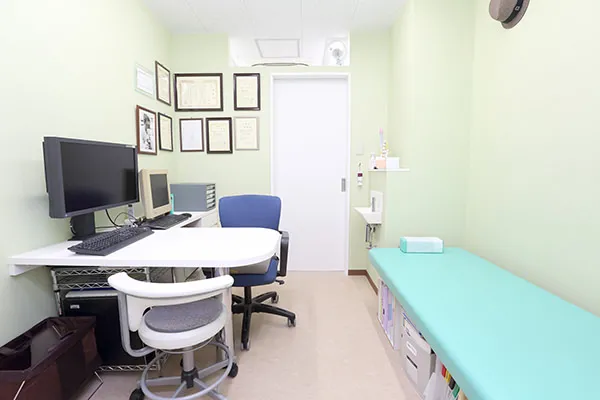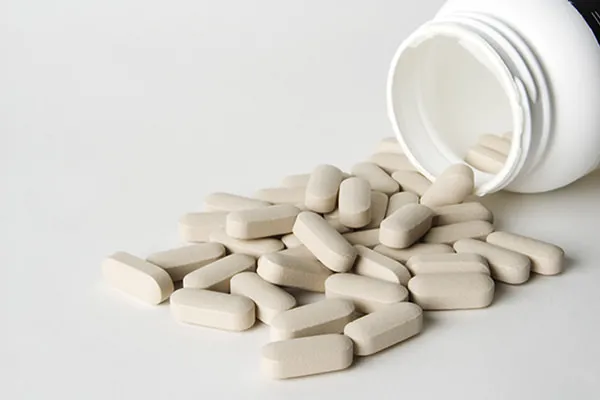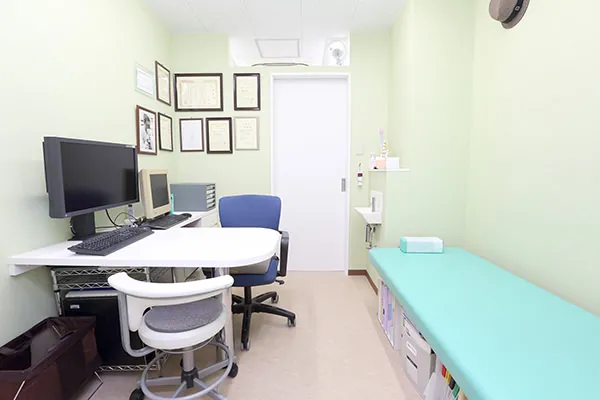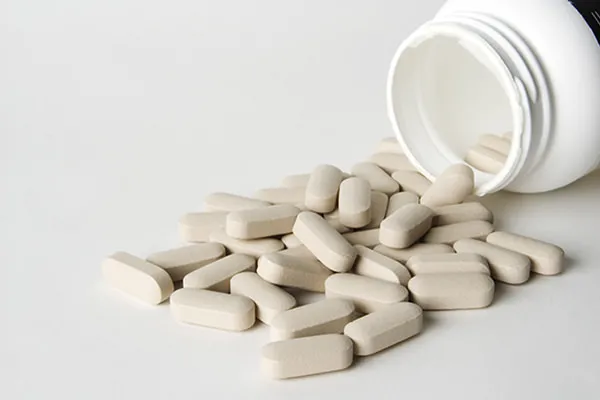Diabetes Treatment Regimen Adjustments (Outpatient)
Providing patient-oriented treatment

While some patients diagnosed with diabetes undergo follow-up observation with a HbA1c value in the 7s and 8s, generally diabetes patients need to maintain a HbA1c value of 7.0 and under in order to prevent complications such as diabetic retinopathy, nephropathy and other vascular lesions.
Although dietetic therapy is important, diabetic patients busy with work and other everyday matters may see their condition worsen if left without an effective alternative means to combating diabetes.
If blood sugar regulation remains poor even after increasing the amount of diabetes-treatment drugs the patient may end up requiring insulin therapy.
Insulin functions by alleviating glucotoxicity.
Glucotoxicity is a characteristic whereby having a high blood sugar level restricts insulin secretion and inhibits its effect.
While insulin can be effective when used properly, many patients who do not require the treatment end up taking insulin.
Insulin therapy can produce some nasty side effects
Introducing insulin therapy into all cases of type 2 diabetes can result in some serious side effects, such as the hardening of the arteries, and it could lead to hypoglycemic attacks. When taking a patient’s QOL (quality of life) in account, we naturally hope to avoid insulin therapy if at all possible.
The Minato Shiba Clinic first uses a glucose tolerance test to measure a patient’s insulin basal secretion volume (C‐peptide), and uses these results to recommend a diabetes treatment that is best suited for the patient.
As new light has been continually shed on the causes of diabetes, new discoveries in diabetes treatments are continually being found.
These new pharmaceutical treatments have reduced side effects, and by combining the use of these treatments in a suitable manner we are now able to control HbA1c and blood sugar levels effectively.
Patients who have been dissatisfied or have had concerns with diabetes treatments in the past are asked to try the new line of treatments we have available at the Minato Shiba Clinic.
Outpatients for diabetes prevention treatment
Supplement treatments also available

This outpatient care service is intended for persons found to be pre-diabetic (an HbA1c value of around 5.9, or a fasting blood sugar level over 109) to prevent future cases of diabetes.
While prevention treatments typically consist of food and exercise, people in the pre-diabetes category are typically in the middle of their working career where continuing restricted diets and exercise treatments can prove difficult.
With this in mind, we recommend the administration of supplements including beta-glucan, dietary fibers and polyphenol as an alternative to dietary treatments.
A glucose tolerance test is used to determine the patient’s condition by measuring changes in blood sugar levels and the patient’s insulin basal secretion volume. The patient’s insulin resistance is then diagnosed based on their insulin secretion deficiency.
Based on these test results, we first look to gradually introducing dietary and exercise treatments that include supplements at a stage where the patient can still turn their blood sugar levels around before they become diabetic with the eventual goal being moving away from pharmacotherapy.
These patients are not considered diabetic. They are treated as having an impaired glucose tolerance.
Supplement costs (one month)
| Beta-glucan (barley) | 18,000 yen (tax excl.) |
|---|---|
| Dietary fiber (burdock, etc.) | 5,000 yen (tax excl.) |
| Polyphenol (catechin) | 9,500 yen (tax excl.) |
Diabetes Treatment Regimen Adjustments (Outpatient)
Providing patient-oriented treatment

While some patients diagnosed with diabetes undergo follow-up observation with a HbA1c value in the 7s and 8s, generally diabetes patients need to maintain a HbA1c value of 7.0 and under in order to prevent complications such as diabetic retinopathy, nephropathy and other vascular lesions.
Although dietetic therapy is important, diabetic patients busy with work and other everyday matters may see their condition worsen if left without an effective alternative means to combating diabetes.
If blood sugar regulation remains poor even after increasing the amount of diabetes-treatment drugs the patient may end up requiring insulin therapy.
Insulin functions by alleviating glucotoxicity.
Glucotoxicity is a characteristic whereby having a high blood sugar level restricts insulin secretion and inhibits its effect.
While insulin can be effective when used properly, many patients who do not require the treatment end up taking insulin.
Insulin therapy can produce some nasty side effects
Introducing insulin therapy into all cases of type 2 diabetes can result in some serious side effects, such as the hardening of the arteries, and it could lead to hypoglycemic attacks. When taking a patient’s QOL (quality of life) in account, we naturally hope to avoid insulin therapy if at all possible.
The Minato Shiba Clinic first uses a glucose tolerance test to measure a patient’s insulin basal secretion volume (C‐peptide), and uses these results to recommend a diabetes treatment that is best suited for the patient.
As new light has been continually shed on the causes of diabetes, new discoveries in diabetes treatments are continually being found.
These new pharmaceutical treatments have reduced side effects, and by combining the use of these treatments in a suitable manner we are now able to control HbA1c and blood sugar levels effectively.
Patients who have been dissatisfied or have had concerns with diabetes treatments in the past are asked to try the new line of treatments we have available at the Minato Shiba Clinic.
Outpatients for diabetes prevention treatment
Supplement treatments also available

This outpatient care service is intended for persons found to be pre-diabetic (an HbA1c value of around 5.9, or a fasting blood sugar level over 109) to prevent future cases of diabetes.
While prevention treatments typically consist of food and exercise, people in the pre-diabetes category are typically in the middle of their working career where continuing restricted diets and exercise treatments can prove difficult.
With this in mind, we recommend the administration of supplements including beta-glucan, dietary fibers and polyphenol as an alternative to dietary treatments.
A glucose tolerance test is used to determine the patient’s condition by measuring changes in blood sugar levels and the patient’s insulin basal secretion volume. The patient’s insulin resistance is then diagnosed based on their insulin secretion deficiency.
Based on these test results, we first look to gradually introducing dietary and exercise treatments that include supplements at a stage where the patient can still turn their blood sugar levels around before they become diabetic with the eventual goal being moving away from pharmacotherapy.
These patients are not considered diabetic. They are treated as having an impaired glucose tolerance.
Supplement costs (one month)
| Beta-glucan (barley) | 18,000 yen (tax excl.) |
|---|---|
| Dietary fiber (burdock, etc.) | 5,000 yen (tax excl.) |
| Polyphenol (catechin) | 9,500 yen (tax excl.) |
Clinic Hours and Location
| Mon. | Tue. | Wed. | Thu. | Fri. | Sat. | Sun. Nat'l Holidays | |
|---|---|---|---|---|---|---|---|
| 9:00~12:45 | ○ | ○ | × | ○ | ○ | ○ | × |
| 15:00~18:45 | ○ | ○ | × | ○ | ○ | × | × |
Kuwayama Bldg. 2nd floor, 2-12-1 Shiba, Minato-ku, Tokyo Googlemaps
4 min. on foot from Shibakoen Sta., 7 min. on foot from Mita Sta., 7 min. on foot from Daimon Sta. and 10 min. on foot from Hamamatsucho Sta.













